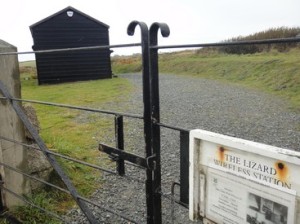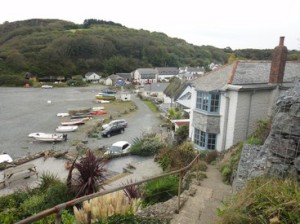The last day of my three-day walk around the Lizard. Today is going to be a relatively short walk from Porthleven south to the village of Lizard. I would be making use of my moped again, so I intended to first drive to the Lizard, drop off the moped then drive to Porthleven and walk back.

It was an overcast morning when I first set off. I’d manage to find a free car park just on the edge of the village. I follow a tarmac road towards Highburrow where the road ends. I walk alongs a newly constructed path, due to the many recent landfalls along this stretch of the coast. The path drops down to Loe Bar, a short raised section of beach which holds back the largest body of freshwater in Cornwall, The Loe.
I climb off the beach continuing south-east. I pass a small memorial, with a white cross dedicated to the 100 or so people lost when HMS Anson was beached in a storm in 1807. I continue along a very level path all the way to the hamlet of Winnianton. Here I find the church of St Willwalloe at Gunwalloe. The church is quite an unusual shape and looks to be into the dune system here. I do not pay a visit, but continue. I pass into another small sandy beach with a minor road. The path soon leaves the road and climbs steadily up a gentle rise to a monument. I am just above Poldhu Cove and this is the site of Marconi’s wireless station, the location where the first transatlantic radio message was sent in 1901.


I walk around a former large hotel, now converted into a retirement home. A short distance on, I pass another hotel above Mullion Cove. The coastal rock formation have suddenly become very dramatic, with a number of large sea-stacks guarding the entrance to the Cove. I continue on along grassy paths with little or no elevation. It has become very sunny now and with the absence of wind it feels just like spring. The dramatic coastline continues with rock of many different colours on show. I pass Soap Rock, previously mined/quarried for Soapstone or talc.

At Kynance Cliff I head due east and drop down into Kynance Cove, one of the Cornish ‘honey-spots’. The cafe down by the beach is very busy and there are many people walking along the beach and exploring the various small inlets. I drop down to the beach nad climb up the far side. I pass a number of Choughs, with their distinctive red legs and beak.
At Caerthillian Cove, I reach the point where I had finished yesterdays walk, so I follow a public footpath into Lizard. The walk has taken 3.75hrs.
Distance today = 13 miles
Total distance = 584.5 miles
****













